

Watch: What is Adolescence, Puberty, and Teenage? Definition, Characteristics, & Stages ... Adolescence, transitional phase of growth and development between childhood and adulthood.

The World Health Organization (WHO) defines an adolescent as any person between ages 10 and 19. This age range falls within WHO’s definition of young people, which refers to individuals between ages 10 and 24. Top Questions How is adolescence defined? Read: Adolescence (15-17 years old) CDC’s Adolescent and School Mental Health Learn how connection is key to good adolescent mental health.
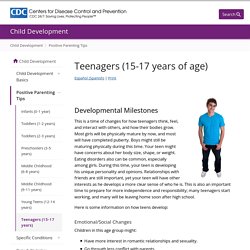
CDC’s Parent Information (Teens 12— 19) This site has information to help you learn how to guide your teen to be safe and become a healthy and productive adult. CDC’s Healthy Weight Information. Read: Stages of Adolescence. By: Brittany Allen, MD, FAAP & Helen Waterman, DO Adolescence is the period of transition between childhood and adulthood.
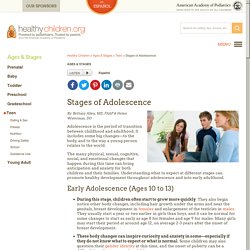
It includes some big changes—to the body, and to the way a young person relates to the world. The many physical, sexual, cognitive, social, and emotional changes that happen during this time can bring anticipation and anxiety for both children and their families. Understanding what to expect at different stages can promote healthy development throughout adolescence and into early adulthood.
Read: The Need for a Sense of Identity. Explanations > Needs > Sense of Identity Identity Formation | Group identity | Social comparison | Identity paradoxes | Identity statements | So what?
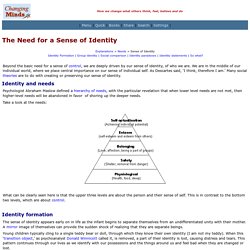
Beyond the basic need for a sense of control, we are deeply driven by our sense of identity, of who we are. We are in the middle of our individual world, where we place central importance on our sense of individual self. As Descartes said, ‘I think, therefore I am.’ Many social theories are to do with creating or preserving our sense of identity. Read: The Search for Identity: Age 12–19. Adolescence is the period of transition between childhood and adulthood.
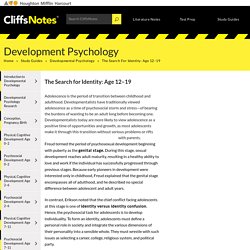
Developmentalists have traditionally viewed adolescence as a time of psychosocial storm and stress—of bearing the burdens of wanting to be an adult long before becoming one. Developmentalists today are more likely to view adolescence as a positive time of opportunities and growth, as most adolescents make it through this transition without serious problems or rifts with parents. Freud termed the period of psychosexual development beginning with puberty as the genital stage. Watch: Erik Erikson's Theory of Psychosocial Development Explained. Read: Erikson Stages of Psychosocial Development in Plain Language.
Erik Erikson is one name you might notice come up again and again in the parenting magazines you leaf through. Erikson was a developmental psychologist who specialized in child psychoanalysis and was best known for his theory of psychosocial development. Psychosocial development is just a fancy phrase that refers to how a person’s individual needs (psycho) mesh with the needs or demands of society (social). Read: Erik Erikson and Self-Identity - Child Development Theory: Adolescence (12-24) According to Erik Erikson, a prominent developmental theorist of the 1950's, youth must resolve two life "crises" during adolescence.
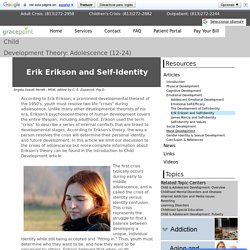
Unlike many other developmental theorists of his era, Erikson's psychosocial theory of human development covers the entire lifespan, including adulthood. Erikson used the term "crisis" to describe a series of internal conflicts that are linked to developmental stages. Read: Erikson's Identity vs. Role Confusion in Adolescent Development.
Identity vs.
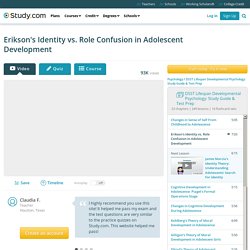
Role Confusion Remember Chaya? She's rebelling against her parents, changing before their very eyes. She's resisting their expectations of her and trying out new and different aspects of herself. Chaya is displaying the adolescent psychosocial crisis that will either lead her to identity, or knowing who she is and what she believes, or to role confusion, or not being sure of who she is or what she believes. Watch: Adolescent Stages of Development. Watch: James Marcia's Adolescent Identity Development. Watch: James Marcia's Identity States. Read: Adolescent Identity Development: What to Expect in Teens.
Adolescent Identity Development: The Factors of Change Among the profound and exciting changes taking place in adolescence is the process of self-discovery. Our teens are working to figure out who they are, making adolescent identity development a central feature of teen life. Young people’s identities are shaped by lots of factors — family, cultural and societal expectations, experiences with institutions like school and the media, and friends. Read: Your Teen's Search for Identity. Their bodies kick into overdrive.

They find themselves disoriented, scared and alone. They become moody, secretive and sarcastic. You don’t recognize your own child. What happened to the child you used to know? Read: How Adolescents Search for Identity - iMom. Menu Search Close Share what kind of mom you are!
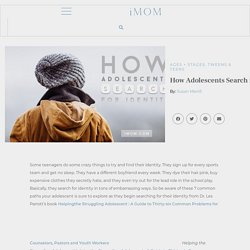
Get to know other mom types! Ages + Stages, Tweens & Teens. Read: 6.3 Adolescence: Developing Independence and Identity – Introduction to Psychology. Learning Objectives Summarize the physical and cognitive changes that occur for boys and girls during adolescence.Explain how adolescents develop a sense of morality and of self-identity.
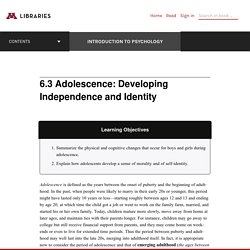
Adolescence is defined as the years between the onset of puberty and the beginning of adulthood. Read: How Parents Can Help Their Teens Develop Autonomy. Children express a desire for autonomy at two stages—toddlerhood and adolescence. This sense of self-governance—feeling, behaving, and thinking independently—becomes particularly profound in the latter set of years, as adolescents have more of an understanding of the world around them and confidence in their own abilities.
While every parent wants their child to grow in this way and doing so is important to living a happy and productive life as an adult, this transition often comes with some difficulties—both for sons and daughters as well as mothers and fathers. Types of Independence. Read: Six Ways to Build Your Teen's Identity - Focus on the Family. Marriages and families are in trouble after the challenges of last year. If it's not too much to ask, would you help equip these families with the resources they need to put Jesus at the center of their home? Yes, I will help struggling families! Read: Identity Achievement and Your Teen. As your child grows up and experiences different phases of development, it might help to know what some of those phases are, and what they really mean in the long run to your tween and his or her adolescent experience. The definition of identity achievement isn't a difficult concept to grasp. It simply refers to having found one's true sense of self.
It is a key element of personality development and a process that begins in childhood, most notably in the tween and teen years, and ends in adulthood. With the tips and examples that follow, get a better understanding of identity achievement and how you can support your children or the young people in your life as they set out on the path of this transformative process. Read: 7 Tips to Help Your Teen Create a Strong Sense of Self. Read: 5 Ways You Can Help Your Teen Create a Positive Identity.